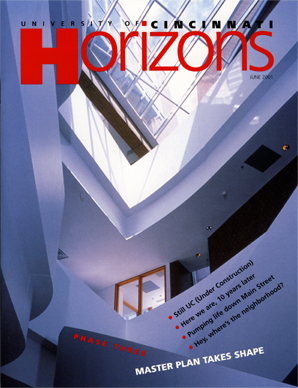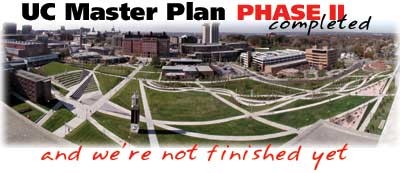by Mary Niehaus
Photo illustration/Jay Yocis
Campus Green is more than a pretty face that replaced a six-acre blacktopped parking lot next to the Alumni Center. Although its lovely green lawns, fountains, gardens, benches and meandering pathways do smile for the camera, the new open space also symbolizes one of the guiding principles behind the University of Cincinnati's campus renewal: "Learning takes place at all times in a range of places in and beyond the classroom."
As Campus Green was dedicated last fall with fireworks and ceremony, it marked a happy ending to another phase of improvements recommended in the UC Master Plan. "I think people feel good about having Campus Green be the final piece of the Master Plan, so far," university architect Ron Kull says. "It is like putting a keystone in an arch, or a cornerstone in a building."
Kull points out that three imperatives have guided the university's renewal of the campus:
- Create more open space and a pedestrianized campus
- Add or upgrade academic facilities
- Establish more connectivity through physical links between East and West Campuses and districts within each campus
The years 1999 and 2000 were such important ones in the scope of the Master Plan that a name was given to the era: "UC Dreams." Besides the Campus Green, eight buildings/complexes and another large green space came to life during that dream:
- The world-famous Frank Gehry created an eye-opening structure for molecular science, the Vontz Center -- artistically referred to as a "sculpture" and jokingly called the "marshmallow building."
- Overnight accommodations, conference facilities and a sophisticated restaurant joined campus in the Kingsgate Conference Center, located next to University Hall, a new office building.
- Signature architect Henry Cobb virtually rebuilt Mary Emery Hall and joined three buildings to form the award-winning CCM Village of the College-Conservatory of Music.
- The campuses of Raymond Walters and Clermont colleges were substantially expanded with three new buildings.
- The College of Allied Health Sciences gained its first home in the former Shriners Hospital.
Prior to UC Dreams, several dramatic changes took place on campus between 1991 and '98, to kick off the Master Plan:
- A multicolored pastel building with walls running at odd angles (the Aronoff Center for Design and Art) sprang up as an addition to the College of Design, Architecture, Art, and Planning and won international acclaim for architect Peter Eisenman.
- A dome-shaped, copper-clad roof finished the Engineering Research Center, drawing much attention for signature architect and UC alumnus Michael Graves.
- French Hall was renovated and a circular structure added to its western side to house University College and the College of Evening and Continuing Education.
- Sigma Sigma Commons and the Tower of Light began transforming the area that would eventually become the new Campus Green.
- The Central Utility Plant opened on Vine Street in a building designed to be neighborhood-friendly.
- The Vera Clement Edwards Center added more than 200,000 square feet of new space plus a garage at Jefferson Avenue and Corry Street.
- The Cardiovascular Research Center was created as a 127,000-square-foot addition to the Medical Sciences Building.
The scope of the Master Plan by landscape architect and planner George Hargreaves and the impressive "signature architects" program UC adopted have brought national attention to the university. The New York Times called UC "one of the most architecturally dynamic campuses in America." The Washington Post wrote that UC's solution to America's stressed campuses was "an experiment worth watching." Individual projects, such as CCM Village, have garnered national honors from the American Institute of Architects. The Vontz Center for Molecular Studies and the Aronoff Center for Design and Art have each merited international notice.
Looking forward to the next step, the university will focus on a fourth imperative: quality of student life and services. Groundbreaking ceremonies took place in January for the new low-rise Jefferson Residence Halls on West Campus, and construction has started on University Pavilion, already nicknamed One-Stop, to make it far more convenient for students to deal with paperwork for admissions and campus life.
"What is important to us is people," architect-planner Hargreaves says. "I was at one meeting when (University President) Joe Steger said, 'This isn't your best work. Go back and bring us your best.' And Ron Kull is the kind of person who says, 'All right, this is a good idea, but how do we get in with a garbage truck and where do the lights go?'
"It takes all that input to make it a cohesive whole. We've been coming here for 13 years. It looks great, but I hate to break it to you; we've got at least another five or six years to go."
We can hardly wait.

 Past Issues
Past Issues